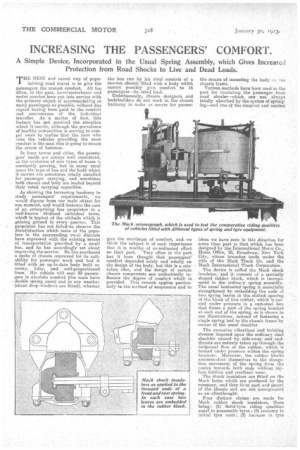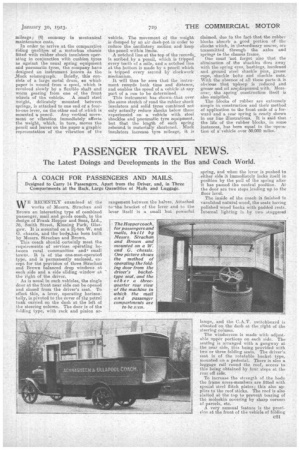INCREASING THE PASSENGERS' COMFORT.
Page 20

Page 21

If you've noticed an error in this article please click here to report it so we can fix it.
A Simple Device, Incorporated in the Usual Spring Assembly, which Gives Increas.e.1 Protection from Road Shocks to Live and Dead Loads.
THE BEST and surest way of popu
larizing.road travel is to give the passengers the utmost comfort. All too often, in the past, havevinotorbuses and motor coaches been put into service with the primary object of accommodating as many passengers as possible, without due regard having been paid. te the cos-Mott and convenience of the individual traveller. As a matter of fact, this feature has not received the attention which it'reerits, although the prevalence of healthy competition is serving to compel users to realize that the man who runs the vehicles providing the most comfort is the man who is going to secure the cream of business.
In busy towns and cities, the passengers' needs are always well considered, as the evolution of new types of buses is constantly proving, but in many rural areas the type of bias and the body which it carries are sometimes totally unsuited for passenger carrying, and sometimes both chassis and body are loaded beyond their rated carrying capacities.
As showing the increasing tendency to study passengers' requirements, we would digress from our main object for one moment, and would instance the case of an enterprising bus proprietor in a well-known Midland cathedral town, which is typical of the attitude which is gaining ground in every quarter. This proprietor has not failed .to observe the dissatisfaction which some of the populace in the surrounding rural districts have expressed with the existing means of transportation provided by a small bus, and he has accordingly set about improving the service. He has purchased a make of chassis renowned for its suitability for passenger work and had it fitted with an up-to-date body built on roomy, lofty, and well-proportioned. lines. His vehicle will seat 20 passengers in absolute comfort (the seats have double spring cases) and in any weather (silent drop-windows are fitted), whereas
the bus run by his rival consists of a one-ton chassis fitted with a body which cannot possibly give comfort to 16 passengers—its rated load.
Unfortunately, chassis designers and bodybuilders do not work in the closest harmony in order to secure for passen gers the maximum of comfort, and, we think the subject is of such importance that it is worthy of co-ordinated effort 011 their part. Very often in the past, has it been thought that passengers' comfort depended solely and wholly on the design of the body-, but this is a mistaken idea, and the design of certain chassis components ean undoubtedly influence the degree of comfort which is provided. This remark applies particularly to.the method of suspension and to
the means of mounting the body on the chassis frame.
Various methods have been used in the past for insulating the passenger from' road shocles—which are nob always totally absorbed by the system of springing—and one of the simplest and neatest ideas we have seep in this direction for some time past is that which has been designed by the International Motor Co., Home Office, 26, Broadway, New York City, whose branches trade under the title of the Mack Thick Co. and the Mack International Truck Corporation.
The device is cared the Mack shock insulator, and it consists of a specially shaped rubber block, which is incorporated in the ordinary spring assembly. The usual laminated spring is materially strengthened by emlajdding the ends of two spring leaves in the slotted opening of the block of live rubber, which is carried under pressure in a cast-steel box that forms a part of the spring bracket at each end of the spring, as is shown in our illustrations, instead of fastening a single spring leaf to the chassis frame by means of the usual shackles
The excessive vibrations and twisting stresses imposed upon the ordinary steel shackles caused by side-sway and endthrusts are entirely taken up throogh the reciprocal flow of the rubber, which is housed under pressure within the spring brackets. Moreover, the rubber blocks accommodate themselves to the elongation movement of the spring from the centre towards both ends without 'sinface friction and resultant wear.
The shock insulators are fitted on the Mack buses which are produced by the company, and they form part and parcel of the chassis and are not incorporated as an afterthought.
Four distinct claims are made for Mack rubber shock insulators, these being: (1)Solid-tyre riding qualities equal to pneumatic tyres ; (2) economy in initial tyre costs; (3) inerease in tyre mileage; (4) economy in mechanical maintenance costs.
In order to arrive at the comparative riding qualitle_5 of a motorbus chassis fitted with rubber shock insulators operating in conjunction with cushion tyres as against the usual spring equipment and pneumatic tyres, the company have designed an instrument known as the .Mack seismograph. Briefly, this connate of a large metal drum en which paper is wound from a spool, .which is revolved slowly by a flexible shaft and worm gearing from one of the front -wheels of the vehicle: A -small steel Weight, delicately mounted between springs, is attached to one end of a fourto-one lever, on the other end of which is mounted a pencil. Any vertical movement or vibration immediately affects the weight, which, in turn, moves the pencil and leaves on the paper a graphic representation of the vibration of the
vehicle. The movement of the weight is damped by an air dash-pot in order to reduce the oscillatory motion and keep the pencil within limits. .
A notched line at the top of the records, is scribed by a 'pencil, which is tripped every tenth of a mile, and a notched line at the bottom is made by a pencil which is tripped every second by clockwork mechanism.
It will thus be seen that the instrument records both time and distance, and enables the speed of a vehicle at any part of a run to be determined.. This instrument has shown -that over the some stretch of road the lubber shock insulators and solid tyres combined not only actually reduce shocks below those experienthcl on a vehicle with steel shackles and pneumatic tyre equipment, but that the length of each spring rebound, is materially shortened. Mack insulators increase tyre mileage; it is
claimed, due to the fact that the rubber blocks absorb a good portion of the shocks which, in thetordinary course, are transmitted through the axles and springs ta the chassis frame.
One must 'not forget also that the elimination of the shackles does away with the spring eyes, bushings, hardened and ground steel shackle pins, grease cups, shackle bolts and shackle nuts. With the absence of all these tarts it is obvious that upkeep is reduced and grease and oil are)dispensed with. Moreover, the .spring construction itself is also sinipified. The blocks of rubber aro extremely simple in. construction and their method of application to the front ends of a forward. and a rear spring is cearly shown in our line illustrations. It is said that the life of the rubber blocks, in some instances, has been equal to the operation of a vehicle over 50,000 miles.'


































